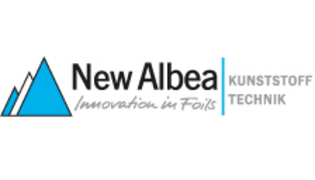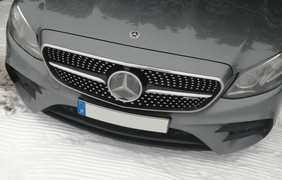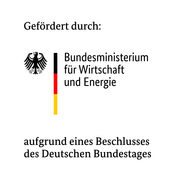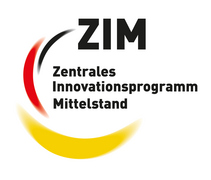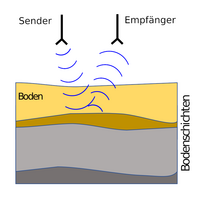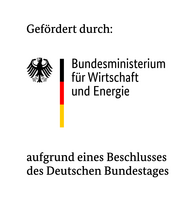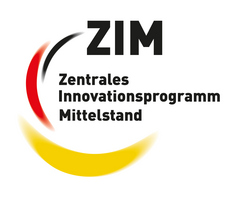Research & Projects
The research and development focus of the institute and their applications are in the areas of:
- Unmanned and autonomous flight systems
- Radar systems and applications
- Antenna and high frequency systems
- Control and automation systems
In the spirit of university-wide internationalization, IUAS has been leading international research and development efforts since its founding year in 2011. To date, IUAS has built up an intensive network with national and international partners, both from industry and from partner universities and research institutions.
Unmanned and autonomous aerial systems
Unmanned aerial systems (UAVs) continue to be an emerging trend with diverse applications such as aerial photography, inspections of high-voltage and other utility lines, or in logistics for the transport of particularly time-sensitive goods. Advances in AI, sensor and battery technology have made UAVs more efficient and easier to operate. Safety, i.e. redundant flight control and propulsion systems, avoidance of collisions in the air and with objects and people on the ground, as well as privacy protection and compliance with data protection guidelines, continue to pose challenges that must be dealt with consciously and responsibly. Thus, UAVs offer a wide range of research tasks and also have great potential for applications in environmental monitoring and disaster relief.
The cell of the autonomous helicopters (ALF) is based on a commercial model helicopter for aerobatics with electric propulsion. The avionics and ground station were developed completely in-house. The avionics consists of a course/position reference system with MEMS gyroscopes and accelerometers, an inertial navigator supported by a barometer and GPS via Kalman filters, and a flight controller. The Flight Controller allows both hovering and stable speed flight.
High dynamics are achieved by means of control loops in several coordinate systems and pilot controls. Bi-directional radio links to the ground consist of several 2.4 GHz data links. The helicopter has been successfully tested under bad weather conditions, including rain, ice formation and up to wind speeds of approx. 50 km/hr. Sensors in the avionics are partially redundant, a possible required in-flight system restart takes place within approx. 30 ms.
The avionics has proven to be very reliable and can be installed in any model helicopter so that other helicopter cells can be used without any problems. In principle, control is carried out via fast setting of waypoints and the course angle, which are specified either via a standard remote control or via a web creation program.
The helicopter has so far been used in various applications, including high-resolution close-ups of the Freiburg Cathedral and power poles. A number of other operations are planned. The operation of the machine is simple and safe; it can be taken over by untrained personnel after brief instruction. The GPS is currently being expanded to include a carrier-phase GPS developed in-house, which will allow significantly higher speed and positioning accuracy than before. In addition, virtual reality components are currently being installed for stereoscopic image capture by the operator.
Technical details of the two main types:
| Name: | ALF60E | ALF80B |
| Drive: | electric | gasoline |
| Rotor Diameter: | 135 cm | 180 cm |
| Weight: | 5,1 kg (inkl. 19 AH battery) | 7,5 kg (dry) |
| Payload: | 3 kg | 7 kg |
| Flight Duration | 30 min (10 Ah battery) | 2,0 h (installed tank) |
IUAS also owns a quadcopter that is used as a testbed for sensors and avionics.
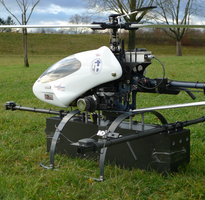
Electric helicopter
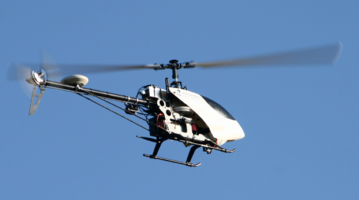
Electric helicopter
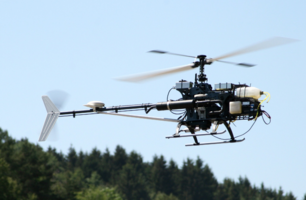
Helicopter with gasoline propulsion
The ELCOD project - Endurance Low COst Drone - was successful in the context of the call for projects "INTERREG V - Science Offensive 2016" with a total budget of 991,918 € (495,959 € ERDF and 249,999 € regional funds).
At present, manned aircraft are generally used for inspection and measurement tasks that require a long range and operating time, which entail considerable costs, high loads and last but not least risks for pilots, crew and material. Unmanned autonomous systems, on the other hand, can only be found in a high-priced market segment and mainly in military applications. With the ELCOD project, the partners at the IUAS of the University of Applied Sciences Offenburg, the INSA and the CNRS/ICPEES in Strasbourg are pursuing the alternative of developing a cost-effective autonomous UAV (unmanned aerial vehicle | unmanned aircraft) for the transport of small payloads, e. g. for use in the area of inspection, monitoring or measurement tasks.
In addition to theoretical studies, design and construction, the project also includes the development, production and demonstration of such a long-haul aircraft, which is projected for a maximum take-off mass of 25 kg, a maximum range of about 5,000 km and a payload of about 5 kg. As an alternative to modern internal combustion engines, the use of an environmentally friendly fuel cell drive is planned and investigated for the propulsion of the aircraft. Areas of application for such a UAV can be found, for example, in border surveillance, the inspection of agricultural areas, rescue or auxiliary missions, measuring tasks for meteorology, the identification of air pollution or the monitoring of air quality. The aircraft must be completely autonomous, fail-safe, all-weather capable (overseas use) and easy and inexpensive to manufacture. The ELCOD project is co-financed by the European Regional Development Fund (ERDF) and regional partners in the Grand Est region of Strasbourg, Baden-Württemberg and Rhineland-Palatinate as part of the INTERREG V Upper Rhine Programme.
Partners:
- http://www.interreg-oberrhein.eu/das-programm/praesentation/
- https://wm.baden-wuerttemberg.de/de/wirtschaft/wirtschaftsfoerderung/foerderpolitik-der-eu/europaeische-territoriale-zusammenarbeit-interreg
- https://mwvlw.rlp.de/de/themen/wirtschafts-und-innovationspolitik/interreg/
- https://www.grandest.fr/

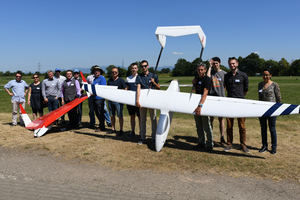
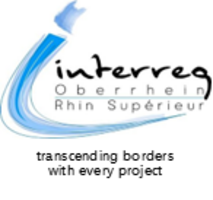
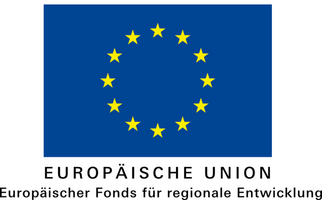
Millimeter-wave Radar
Millimeter-wave radars a variety of different measurement and application possibilities. In the automotive sector, for example, these include the precise detection of vehicle and pedestrian speeds, the measurement of distances to objects, the determination of the direction of motion of objects, and the detection and classification of obstacles. In addition, millimeter-wave radars can be used to study the reflective properties of surfaces and materials to improve the identification and classification of objects.
Development of a technology platform for automated product and production configuration of radar-transparent radome heating foils with customized geometry and functional characteristics.
Radar has been an integral part of modern vehicles for several years. For design-compatible integration, radar sensors are increasingly being concealed behind bumpers and emblems. Since full functionality must also be guaranteed in winter, disruptive snow and ice deposits can be avoided with the aid of foil-integrated resistance heaters. The aim of this research project is the automated design of the heating foil according to the required heating power while at the same time ensuring the permeability for radar waves.
Together with the company New Albea, an application for automated layout generation and the optimal radar-transparent design of these heating foils is being developed and researched as part of the joint project "Development of a technology platform for automated product and production configuration of radar-transparent radome heating foil with customized geometry and functional characteristics", funded by the Central Innovation Program for SMEs (ZIM).
The University of Applied Sciences Offenburg is a member of the joint project Programmable Systems for Intelligence and Automobiles (PRYSTINE), which is funded by the Electronic Components and Systems for European Leadership Joint Undertaking (ECSEL) and the German Federal Ministry of Education and Research (BMBF).
Within the PRYSTINE project, a fault-tolerant 360° all-round perception for highly automated driving is being developed, which is based on robust radar and lidar sensor fusion.
In the sub-project "Design of the system architecture of radar sensors based on identified scenarios", Offenburg University of Applied Sciences is involved in the specification and design of a system architecture for a novel RF-CMOS-based radar chip for the 76 - 81 GHz frequency range. The realization will be followed by various investigations for the validation of the radar system. The goal is to develop a future-proof CMOS-based radar system that is characterized by high robustness and high fault tolerance.
https://www.ecsel.eu/projects/prystine
Link to the report in the university magazine "Forschung im Fokus":
https://www.hs-offenburg.de/fileadmin/Einrichtungen/iaf/file/FBericht/FIF_2021_Webseite1.pdf
Publications:
- R. Y. Kodari, M. Rösch and M. Harter, „Analysis of Amplitude and Phase Errors in Digital-Beamforming Radars for Automotive Applications“, 21st International Radar Symposium (IRS), Warsaw, Poland, 2020, pp. 391-395.
- Musralina, R. Y. Kodari and M. Harter, „Investigation of the Angle Dependency of Self-Calibration in Multiple-Input-Multiple-Output Radars,“ IEEE Asia-Pacific Microwave Conference (APMC), Hong Kong, Hong Kong, 2020, pp. 576-578.



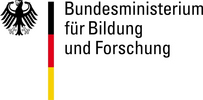
Ultra-Wideband Radar (UWB-Radar)
Research in the field of ultra-wideband radar (UWB) focuses predominantly on the non-invasive penetration of objects and materials for the creation of three-dimensional models or for the detection of objects. Examples include non-contact analysis of soil layers or detection of foreign objects in food. With the continuous optimization of algorithms, improvement of resolution and ranges of UWB radars, this technology opens new possibilities for innovative solutions in various fields.
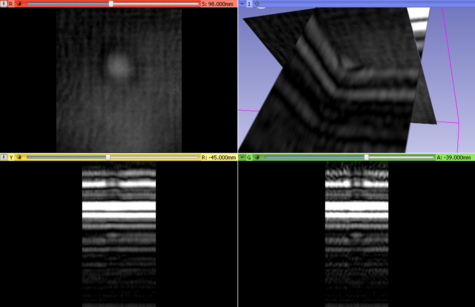
The aim of the GPR project is to use radar radiation to view the interior of various optically opaque objects and to generate three-dimensional models from the data.
Procedure:
A broadband RADAR signal is transmitted to the material under investigation via special antennas. In the event of impedance changes - such as occur in the case of impurities - the beams are reflected and refracted in accordance with the laws of high-frequency technology.
The reflected rays are received with a receiving antenna and electronically isolated. With signal processing, the received data is combined into a 3D image and can then be viewed in a 3D visualization program. The above pictures show the raw data for a metal ball, which is slightly elevated above the ground, in a 3D view.
Development of a non-contact analysis method for the detection of soil layers using radar - RADALYSE.
As a natural material, there is a wide variation in the nature of soils. Even within small construction measures this can be considerable. In the run-up to a construction project, the soil properties to be found can only be determined by random sampling of the subsoil (costly and time-consuming drilling).
Deviations between the presumed and the actual ground conditions between the drillings occur regularly. As a result, there is a corresponding cost uncertainty when planning civil engineering work for road, bridge or house construction.
The aim of the project is to develop and evaluate a novel non-contact analysis method for the determination of soil layers and occurring anomalies, such as bedrock or channels. The system should enable fast and simple layer analysis, so that more precise spot soil analyses can be better planned via test borings.
The RADALYSE project, funded by the Central Innovation Program for SMEs (ZIM), is being carried out jointly with the company vigram.
During the industrial production of food, foreign bodies such as glass splinters, stones, plastics, ceramics or metal parts are occasionally added. Meat or fish products often still contain parts of bones or bones, fruit products (e.g. jam) seeds, stones or pieces of wood. Such foreign bodies can harm and injure consumers and must therefore be detected in good time at the end of the production line.
Nowadays, foreign bodies in food are detected with X-ray scanners. The application of this technique is complex, expensive and requires special radiation protection. For this reason, work is being done on alternative methods that can replace the X-ray method in special applications. This can be achieved with low-energy electromagnetic waves in the GHz and THz frequency range.
At the IUAS Institute, a measuring system is being developed that uses radar technology to detect foreign bodies in foodstuffs in the lower GHz range. The system takes advantage of the fact that foreign bodies reflect electromagnetic radiation in a characteristic way. The FMCW radar is a broadband MIMO system. The speed of foreign object detection is a particular challenge, since the available time is in the range of one second per target.
The industry has high expectations for radar technology. For this reason, it has been additionally supporting the development with a considerable sum for a few years.
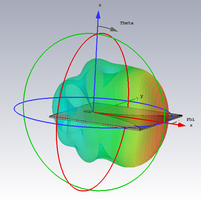
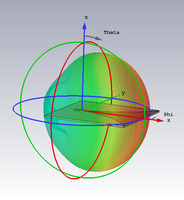
Antenna and High Frequency Systems
Antenna and radio frequency systems offer numerous applications. They enable wireless communication over long distances, directional control, at high bandwidth and fast data transmission. They find application in mobile communications, satellite communications, IoT, 5G, radar, remote sensing, medical imaging and industrial measurements.
Skin cancer is the most frequently diagnosed type of cancer in Germany. Every year, more than 200,000 new cases are diagnosed in Germany alone. According to WHO estimates, there are two to three million new cases worldwide every year. The most dangerous type of skin cancer is black skin cancer or malignant melanoma with approximately 20,000 cases per year in Germany and several thousand deaths.
The diagnosis of skin cancer is still based on visual techniques, where the detection rate can vary between 56% and 80%, depending on the experience of the diagnostician. Millimeter waves are a promising way to improve the accuracy of the diagnosis. For this purpose, the fact is used that the water content of skin cancer is different from healthy skin, which in turn is reflected in a change in the reflection of electromagnetic waves.
Together with the Karlsruhe University of Applied Sciences, skin cancer detection with millimeter waves is being researched.
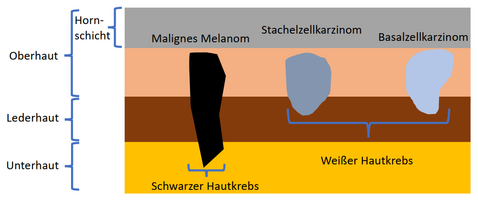
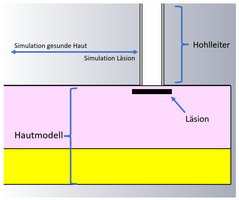
Control and Automation Techniques
Control and automation techniques such as MPC and control of networked systems provide advanced solutions to complex control requirements. MPC uses mathematical models to optimize systems, while control of networked systems enables the coordination of networked components. These techniques improve precision, flexibility and energy efficiency in areas such as process control, robotics and intelligent transportation systems. They are critical for effective control and automation of complex systems and improve their efficiency and reliability.
Model predictive control (MPC) is one of the most successful advanced modern control methods, which can achieve very high control performance, especially in the context of nonlinear operating states, through continuous real-time optimization of the control inputs. Due to increasingly faster CPUs, the method can also be used in the sub-millisecond range, i.e. in particular also for mechatronic systems.
One investigated field of application is the use of MPC to optimize the navigation of renamed flight systems, such as the control of drones of airborne wind turbines.
For this purpose, MPC computes setpoints for the underlying control loops of the basic control system (altitude, airspeed, and attitude control).
Information about airborne wind turbines:
An airborne wind energy system (AWES) converts wind energy into useful electrical energy using an unmanned fixed-wing aircraft attached to a tether but flying freely. The motivation in developing an airborne wind energy system is to minimize the material required to build a conventional wind turbine. Thus, in general, the construction material of a wind energy converting turbine is always most efficiently used where the material is moving fastest relative to the wind. For example, in a conventional wind turbine, 70% of the energy conversion occurs at the outermost 30% of the rotor blades. The basic idea of an airborne wind turbine is to implement only this fast-moving part, i.e., a blade that moves quickly across the wind and is connected to the ground by a tether. If the tether is connected to a generator winch located on the ground and periodically retracted and extended, electrical power can be generated (illustration: see Figure 1).
In this case, the rope is unwound from the winch by the high aerodynamic forces applied to the wing, thus generating useful electrical power in the generator (unwinding mode). In retraction mode, the flight system is steered to a trajectory of reduced rope force and the rope is retracted with the generator acting as a motor, consuming energy. Net electrical energy is generated by periodic unwinding and rewinding.
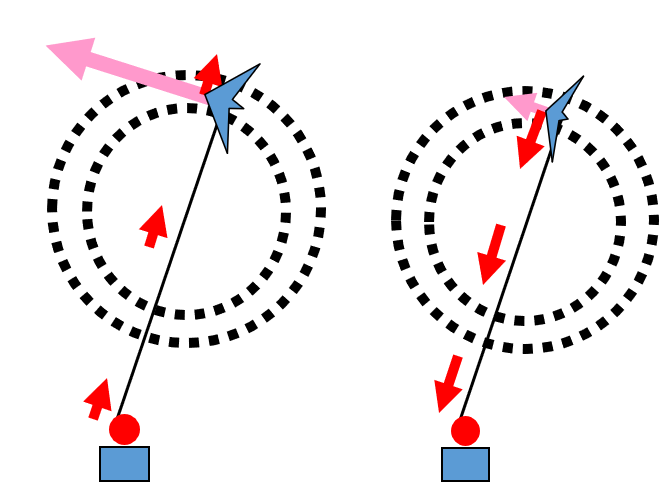
Complex control systems, such as autonomous flight systems, usually have a distributed hardware architecture in which the command variable generator, the controllers and the sensors are implemented by separate components, which may be networked with each other via communication channels that are not hard real-time capable, such as wireless links. Due to a failure of the communication link, data can only be transmitted with a delay or even be lost completely. One issue under investigation is how these effects can be minimized by co-designing the control algorithm and communication protocol.
In the field of control of networked systems, control methods are being developed that are optimized for use in distributed systems.
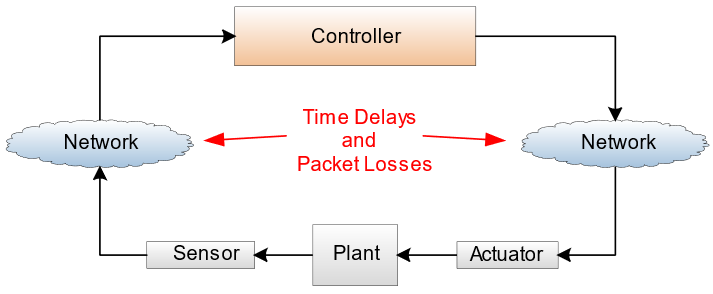
Regelung vernetzter Systeme (Veranschaulichung)
